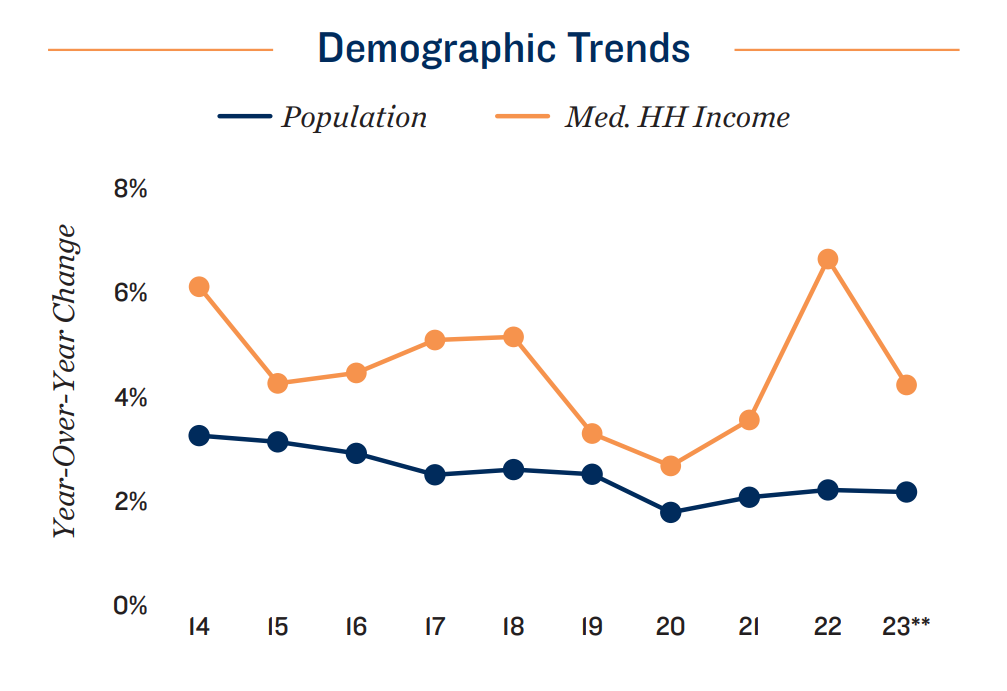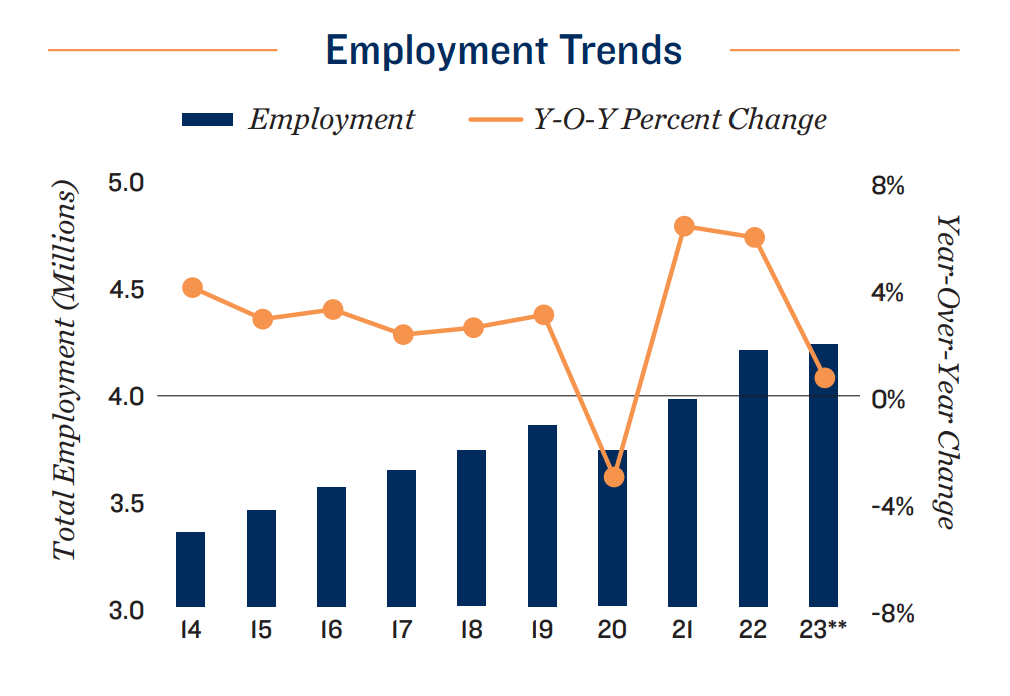2023 Marcus & Millichap Self-Storage Investment Forecast Report
Austin Market: Continual Inflow of New Residents Drives Demand
Economic Overview
Austin’s job count will continue to climb this year, albeit at a reduced pace. Several large companies are currently expanding in the market, which will support construction-related hiring over the near term and higher-paying job creation beyond 2023. Apple is one such firm, with the company building a campus in Northwest Austin that will house 5,000 employees after its first phase of completion.
Demographic Overview
Net in-migration will surpass the 30,000-resident mark for the ninth time in 10 years, ranking Austin as one of the top markets for relocations in 2023. This sustained movement into the metro will supplement self-storage demand as new residents and households settle into apartments and homes. Additionally, in-market movement may become more prevalent as living expenses rise, a boon for storage facilities in lower-cost locales.


Construction Overview
Substantial population growth should provide demand for this year’s construction pipeline. Of the projects coming online in 2023, over 270,000 square feet is slated for the fast-growing city of San Marcos — an area popular among individuals and households seeking lower-cost living options proximate to both Austin and San Antonio.
Vacancy/Rent Overview
The pace of rent growth mirrors last year, despite a moderate increase in vacancy, pushing the average asking rate to a new high. Record rent is supported by notable population growth, with storage facilities in expanding neighborhoods and cities, such as San Marcos, positioned to register more pronounced rent gains.



Dallas-Fort Worth Market: Nation-Leading In-Migration Drives Storage Demand
Economic Overview
In 2023, Dallas-Fort Worth will add the second-highest number of new positions nationally to its employment count. Growth in the leisure and hospitality sector, as well as in the traditionally office-using segment, will highlight these gains. Company expansions into the market — though beginning to slow amid mounting economic headwinds — have fueled most of the recent hiring and incentivized individuals to relocate to the Metroplex.
Demographic Overview
Dallas-Fort Worth tops all metros nationwide by the amount of total new residents in 2023. Despite moderating hiring velocity, net in-migration is expected to be the largest in the country for a third consecutive year, stoking this expansion. As new residents move in, demand for self-storage will hold strong.


Construction Overview
More square footage is expected to come online in Dallas-Fort Worth this year than in any other U.S. market; yet, the delivery volume will trail the Metroplex’s prior five-year average of over 3 million square feet. Fort Worth is slated to receive the majority of completions. The fast-growing outer cities of Carrollton and Melissa in North Dallas are both expecting 200,000-plus-square-foot projects.
Vacancy/Rent Overview
The average monthly rate will advance the fastest in Fort Worth, rising to $1.02 per square foot. The city is likely to continue to see increasing self-storage demand as some neighborhoods offer living cost advantages to Dallas. Commuting residents seeking lower housing expenses, or employees with remote work flexibility, may opt for Fort Worth.



Houston Market: Regionally-Low Housing Costs Aid Storage Demand
Economic Overview
Houston adds the fourth-highest number of jobs among major U.S. markets this year. Despite slowing from 2022’s historically high headcount expansion, employment opportunities are still prevalent, drawing out-of-market residents and contributing to sustained household formation in 2023.
Demographic Overview
In 2023, the median household income for Houston residents is expected to rise 4.7 percent year-over-year, the largest increase among major Texas markets. This, paired with a lower average effective apartment rent than Dallas-Fort Worth or Austin, is a major factor drawing in-state relocations to Houston. In-migration will account for over 57,000 of this year’s new residents.


Construction Overview
Several large projects spearhead the 2023 pipeline. Conroe, Tomball and Houston proper are all expecting builds exceeding 100,000 square feet. These three areas account for two thirds of the active pipeline. More cost-effective living options can be found in outer cities, allowing supply here to benefit from greater in-migration. Conversely, Houston proper may face headwinds in the near term as nearly 400,000 square feet comes online here.
Vacancy/Rent Overview
Although availability will rise this year, the 2023 rate will land 90 basis points below the long-term average. As supply and demand rebalance, the mean monthly rent will slide by $0.01 per square foot. Houston retains the lowest monthly rate among major Texas markets, but also the second-lowest vacancy, potentially allowing for future rent gains.



San Antonio Market: Low Supply in Outer Cities Contradicts Growing Demand
Economic Overview
Although employment base additions trail last year’s 4.3 percent expansion, job opportunities are still drawing new residents to the metro. The leisure and hospitality sector alone added nearly 8,300 positions in 2022, a 4 percent headcount increase from 2019.
Demographic Overview
San Antonio retains the lowest apartment rent among major Texas markets, encouraging in-migration to the metro. By the end of 2023, the market will have gained over 249,000 out-of-market residents over the last 10 years. Sustained population growth, particularly from relocating households, will underpin self-storage demand through this year. Facilities in outer cities may especially benefit from in-migration as Austin and San Antonio become increasingly intertwined, drawing residents to suburbs located in between.


Construction Overview
Self-storage facilities in submarkets between San Antonio and Austin will be aided by a dearth of new supply. As of January 2023, nearly all of the deliveries coming online this year were slated for San Antonio proper. This may create vacancy challenges for some urban areas in the near term, but historically moderating supply additions will mitigate headwinds.
Vacancy/Rent Overview
Availability in the metro has remained relatively consistent since 2019. As other markets noted major vacancy swings during the three years prior to 2023, San Antonio kept its annual rate of availability between 6.7 percent and 7.5 percent. This stability continues to justify a rising average monthly rent, albeit at a slower pace this year than what was recorded from 2019 through 2022..



